Don't wanna be here? Send us removal request.
Text
RPG Draft Complete
I've finished a first draft of my Cepheus Engine RPG based on my @para-imperium setting, specifically set during the same era as the serial story Horizon: Salvaged Heroes.
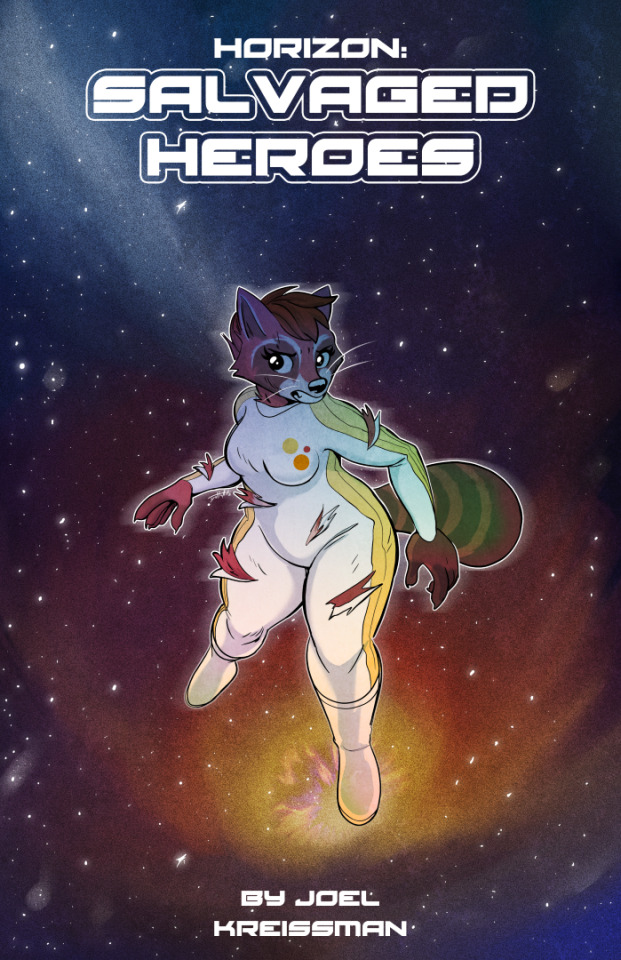
The Cepheus Engine is based on Traveller, with straightforward 2D6+modifiers rolls and a lifepath system of character creation (I tried to make it less lethal), but under an open license.
Campaigns take place after the collapse of an interstellar empire, and focus on salvaging the wreckage it left behind. Something like a cross between Hardspace Shipbreaker, The Expanse, Lethal Company, and Isaac Asimov's Foundation.
Most characters will be the descendants of genetically engineered "parahumans" designed for colonizing space. I've created a system of traits and adaptations for building custom parahuman genotypes.
If that sounds interesting, you can check it out at my Patreon on https://www.patreon.com/posts/rpg-first-draft-117229171?utm_medium=clipboard_copy&utm_source=copyLink&utm_campaign=postshare_creator&utm_content=join_link
I'm still working on the title. How does "Salvaged Heroes: Post-Apocalyptic Space Opera" sound?
I’ve got two other books in this setting if you’d like to check them out.
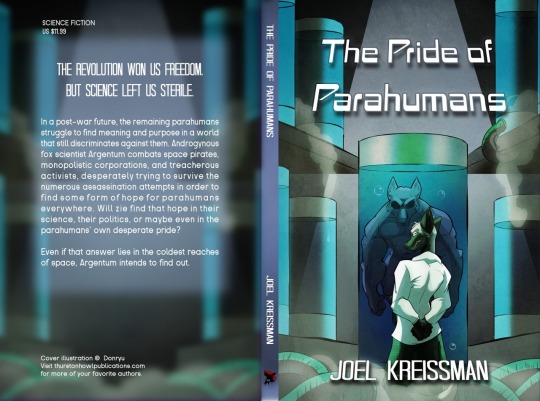
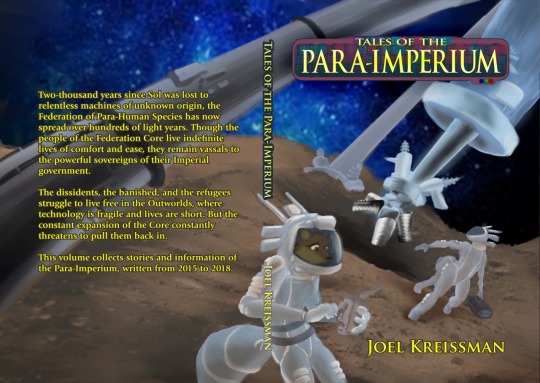
1 note
·
View note
Text
Parahuman Space
While Stardrives is complete, I'm not done with TTRPG writing yet. I've been working on the @para-imperium setting for over a decade now and I'm almost ready to launch a complete RPG based on the Cepheus System derived from Mongoose's Traveller (but more open).
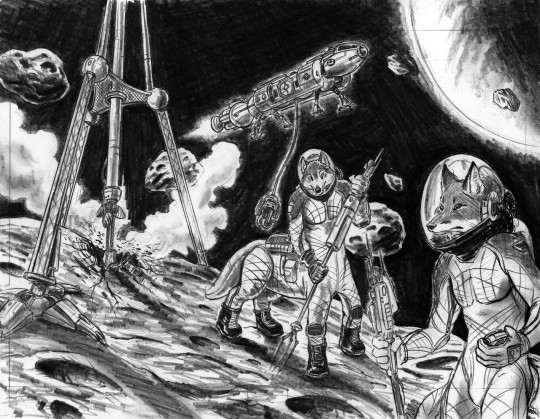
Parahuman Space is a furry setting, yes, of the genetically modified variety. It covers over 2,000 years, but the RPG will be focused on the period after the collapse of the big interstellar empire. When newly independent planets and systems are busy scavenging the wreckage.
Players will primarily be salvage crews venturing into hazardous ruined spaceships and stations. Braving haywire security systems, leaks of corrosive chemicals, and the dreaded Kessler Syndrome to retrieve valuable technology.
In other words, dungeon delving.
At present I am about halfway done drafting the rulebook, drawn heavily from the Cepheus System Reference Document that can be read online here. Once I'm finished and I have interior artists lined up I was hoping to bring it to Kickstarter.
Below is the setting's history, as written for the rulebook.
Timeline:
Most calendars in Parahuman Space are oriented around the launch of the first parahuman-built starship as the start of the exodus from the clade’s system of origin, Sol. On the Georgian calendar the year 0 Post Exodus (PX) would be in the early 22nd century AD. So the Federation would be founded in the 32nd century AD and collapse in the 45th century, or roughly the year 4600 AD.
-40 Before Exodus: Creation of parahumans. -24 BX: Parahumans emancipated and corporations that enslaved them dissolved. -17 BX: Events of The Pride of Parahumans. 0 Post Exodus: First Seedship, the Traveller, launched. 4 PX: Pallas launches second seedship. 10 PX: Earth destroyed by relativistic projectile, origin unknown. 14 PX: Second Pallene seedship is caught by berserker probes that destroyed Sol. Crew commit suicide first. 45 PX: Traveller lands on a planet orbiting Alpha Centauri A, creatively named "Secland." 48 PX: Vestan ship lands on opposite hemisphere from the Traveller.
115 PX: Ship from Ceres arrives at Epsilon Eridani to find a lifeless system. Instead of terraforming the new corporate government opts to build artificial habitats in the asteroid belts and beneath the surfaces of planets.
124 PX: A second Vestan ship discovers a garden world orbiting Tau Ceti. The crew decide to eschew technology after printing enough colonists in fear of Sol’s Destroyers.
150 PX: Sleeper ship carrying 1500 humans from Sol arrives over Secland. After an abortive attempt at invasion the survivors gradually integrate into Pallene society. 500 PX: Cold war between nations on Secland ends with the completion of terraforming. Biological weapons leave New Pallas the sole nation standing. 950 PX: New Pallas contacts Tau Ceti thanks to the newly developed conversion drive. Triggering political restructuring among the natives resulting in the kingdom of Schwarswelt under King Hideo Fink.
1060 PX: Stable wormholes large enough to move a spaceship through are produced and launched from Proxima Centauri to Tau Ceti and Epsilon Eridani. 1100 PX: Alpha Centauri, Tau Ceti, and Epsilon Eridani form the Federation.
1150 PX: Centauri Grand Mayor Selkd de Argentum assassinated by Cetan partisans and succeeded by his more aggressive sister Lirdrill.
1200 PX: The Federation centralizes power in the office of the Praetor, first held by Lirdrill de Argentum.
1205 PX: The Outworld memetic quarantine and contingency program is established, forcibly relocating ideological dissidents to frontier worlds with limited technology.
1500 PX: After extensive lobbying by Centauran merchant houses and the Eridani Company, Federation Senate votes to allow limited trade with Outworlds, which now compose roughly half of all colonized planets.
1846 PX: Kershkans, the first extant xenosophont species, discovered. 1903 PX: Contact established with Kershkans. 2300 PX: Federal Guard destroys Sol with strangelet bomb, inducing a nova. Evacuation of Core Worlds begins. 2304 PX: Wormhole gates at Alpha Centauri collapsed ahead of the nova's radiation. The capital cut off, the Federation quickly begins to fragment. 2345 PX: The Emissary-Governor of the Tiere System, wracked by tensions between earlier colonists and new refugees, disables all nanotech in the system in an attempt to reassert control. He is lynched by an angry mob within weeks. 2590 PX: The self-proclaimed Imperator Ronkal launches Project Paladin, sending ships with new reactionless drives and augmentation suites to neighboring systems. 2600 PX: A Ronkalli ship reaches the Tiere System, only for interplanetary debris to kill the entire crew. The ship AI forcibly augments a crew of scavengers who come looking.
The Origin of Species:
The first parahumans were engineered from a blend of human and animal genes and bioprinted in corporate labs in high Terran orbit. They were designed to fill roles in asteroid mining that were too complex for robots but too dangerous to risk human life for. It took less than a decade for rebellions and strikes to start.
Fortunately, the parahumans found many allies on Terra and after the revolutionaries on Ceres worked out a treaty to maintain the flow of resources back to Terra they were essentially left to themselves. With their new freedom came disagreements over how to govern themselves. The guilds on Vesta formed a form of anarcho-capitalist feudalism regulated by the cloning guild that held the early parahumans’ sole means of reproduction. But then a Vestan scientist, a silver fox named Argentum, discovered a simple gene therapy to remove the genetic sterility imposed by their creators and their followers formed a breakaway colony on Pallas.
The Vestan guilds could not tolerate this loss of control and war almost broke out between the two asteroids. Luckily they found an alternative means of proving the superiority of their respective systems of governance. A space race. Exploration of other star systems had been proposed many times but there had been little interest with the abundance of resources right there in Sol system. But with the new nanofabricators it was possible for even a small asteroid outpost to construct an Orion-style starship with a small crew and the fabricators to print out an entire new colony, colonists included.
They couldn’t have timed the launch better. Just ten years after the first starship, the Traveller,was launched from Pallas towards Alpha Centauri, it received a frantic message from Sol:
“This is an automated beacon broadcasting what may well be the last message ever sent by the human race. Five years ago, our homeworld, Terra was struck by a 50-ton projectile traveling at 90% of the speed of light. The debris took out most of our habitats in Earth’s orbit, a few million of us survived elsewhere in the solar system. Then the rest of the invasion force arrived. Machines, vast machines kilometers in length that home in on any sources of radio transmissions, and annihilate them. We pray they are not intelligent and are simply weapons fired by a xenophobic alien race. But they’ve almost completed their work, we estimate that there’s only a couple hundred of us left in the system. We’re sending this message in hopes that there is someone out there who can hear it and beware. This universe is more hostile than we thought. They attack radio transmitters, dismantle whatever devices you are listening to this on before they find you.”
In total, five starships were far enough out to heed this warning. The Traveller, a Vestan ship also headed for Alpha Centauri, a second Vestan ship on course for Tau Ceti, a craft launched from Ceres to Epsilon Eridani, and the largest but slowest ship, a sleeper ark from Terra to Alpha Centauri.
Alpha Centauri: Sol’s Nearest Neighbors
Around Alpha Centauri A the Traveller found a Terra-sized rocky planet that had long been scoured of life by stellar storms from the trinary stars nearby. It was determined that this little rock could be reanimated with comparatively little effort and the crew made immediate plans to colonize and terraform the planet which they named “SecLand” (the landing on Pallas being the first land).
Just three years after the Traveller’s arrival, they were followed by their Vestan rival. Considering the horror they’d experienced since Sol’s last transmission they decided to set their differences aside and work together on terraforming SecLand, albeit from opposite hemispheres. This detente was strained at times, but the first real threat to world peace didn’t come until 150 years PX, when the ark carrying the last of unaltered humanity arrived.
By the time the sleeper ark arrived SecLand had a population of several thousand, the ark carried a mere 1500 passengers but over half were soldiers who’d entered stasis with orders to make sure that the first exosolar foothold of humanity was human, not parahuman. Or at least that was the plan, when word of what happened to their homeworld got out there was a mutiny and the victors immediately surrendered to the parahuman colonists, with most passengers integrating into the Republic of New Pallas. These newcomers brought a wide range of skills and knowledge, living knowledge, to a planet whose inhabitants up until then had primarily only known life inside their half-built habitat structures. The humans emigrated nearly equally to both colonies, over the centuries they interbred with the parahumans, with the net result being that many SecLanders have less fur or their facial features are closer to human than many further colonies. Today pure-bred humans, and parahumans (excepting uplifts), are miniscule minorities on SecLand with only a couple million individuals. The average SecLander resembles a blend of at least half a dozen species of Terragen origin.
For centuries the two colonies lived in relative peace, New Pallas breeding like rabbits while the Vestans cloned new citizens in bulk. But when the terraforming of SecLand had reached the point where colonists could breathe the atmosphere tensions re-established themselves between the two old enemies. With terraforming nearing completion some wondered what use New Pallas could have for the Vestans, on both continents. To that end the Vestans began to covertly build weapons in their Arcologies while New Pallas shifted their orbital satellites slightly. It all came to a head when the Vestans concealed a lethal virus in food shipments sent from their farms to the cities of New Pallas, thousands died in the months that followed. By the time the New Pallas government realized what had been done every Vestan arcology had unveiled surface-to-orbit mass drivers that could shoot down their enemy’s satellites. Even then, many arcologies were leveled by orbital strikes. Then the land battles began. The cybernetically augmented citizen-soldiers of New Pallas facing off against the bioprinted legions of the Vestans. The fighting raged on for months, then abruptly, it ceased less than a year after the war had begun. You see, the Vestans had underestimated New Pallas’s skill with biotechnology, crafting a virus that could be deadly to all the diverse inhabitants of the Republic had been difficult, but a dirty little secret of many 21st century regimes were the techniques to engineer a virus that had disastrous effects when it interacted with a specific gene or genes. And the Society for the Preservation of Parahuman Species had only used a couple genotypes for their army, and even fewer for their ruling priest-scientists. Once the virus had been grown any Vestan unit that came into contact with the enemy was dead within a week, in a month the ruling class had been reduced to a few paranoid individuals who had sealed themselves in hermetic bunkers. Specialized by repeated cloning into an effective caste system, and their soldier castes suddenly extinct, the surviving Vestan arcologies found themselves helpless against New Pallas occupation forces.
The medical advances achieved fighting the bioweapons led to the development of leukosynths, symbiotic microbots that could fight off nearly all microbes and repair the body at an accelerated rate. Even fighting off the advances of aging. When this “immortality” was proven to the public they clamored for the government to subsidize their deployment to the masses. Within the century 90% of New Pallas’ population enjoyed the benefits of leukosynths.
Among this chaos a new power emerged in the Pallene cities and settlements. Families all over the planet started giving birth to silver fox kits, reminiscent of their colony’s nearly-deified founder, Argentum. Some religious leaders saw this as a sign and exalted these silver foxes, propelling many into high positions in politics. The cynical suggested that the parents had modified their children’s genes in-utero, but after the plagues many people were desperate and willing to believe anything. Most of them were actually descendants of Argentum’s, but their progeny numbered in the hundreds of thousands by that point anyways.
An unintentional side effect of this bit of social engineering was a renewed interest in their origins out in the depths of space. And despite the terrors they knew awaited them they couldn’t help but wonder if any other colony ships had made it…
Epsilon Eridani
Ceres, the largest asteroid in Sol’s asteroid belt, was the main off-world base of operations for the corporation that created the first parahumans. During the revolution parahumans took over the local branch offices and largely continued to operate along the same lines. Their participation in the exosolar space race was almost an afterthought, an attempt at remaining relevant compared to the other two major asteroid civilizations in Sol system.
Upon arrival in the Epsilon Eridani system they found even fewer viable prospects for terraforming than those in Alpha Centauri. Instead, they opted to construct enclosed habitats in the system’s asteroid belts and under the surface of the larger rocky planets. Like on Ceres the colonists retained the corporate style of government that had served their forebears fairly well.
After about a century of this arrangement dissatisfaction among the lower ranking employees spread towards the shareholding class. A bloody revolution followed, after which the revolutionaries distributed the seized shares in the Eridani Company equally among the employees, granting everyone a vote in company elections and a share of the profits. Roughly a generation later a group of managers started buying up shares from others.
The third such regime made contact with a probe from New Pallas, trade began almost immediately.
Tau Ceti
The second Vestan colony ship took over a century to reach its destination, the star Tau Ceti. Along the way two generations of crew were decanted from the ship’s bioprinters to replace their predecessors. While the final crew were genetically identical to those who had set out from Vesta their commitment to the ideology of the Society for the Preservation of Parahuman Species had wavered, and with the news of Terra’s destruction some suggested that perhaps the best way to avoid sharing that world’s fate would be to lose their advanced technology.
That would require them to give up cloning as a means of reproduction, however they were unwilling to allow reckless crossing of genelines so they added genetic markers to prevent different phenotypes from interbreeding. Fortunately, unlike the other colony ships they discovered a lush world that wasn’t too hostile to Terran life which they named Schwarzwelt after the dark colors of the local chlorophyll analogue. They then settled each “species” into different “clans” in different regions of the planet. The clans grew in population rapidly, bumping up against the borders designated at founding in less than a century. War broke out.
Clans rallied behind charismatic warrior-nobles and weaker clans swore oaths of fealty to stronger ones to save their own skins. These wars continued until contact with the first probe from the Centauri system, realizing that there was another civilization out there and that they were capable of interstellar travel the clan heads held a council to decide what to do about it. The majority ruled that they needed a single man to represent their world when the outsiders came in person, they elected King Hideo Fink of the feline clan as the official ruler of Tau Ceti.
Birth of the Federation
While the first manned starships with conversion drives were still traveling to their neighbors, scientists at a research base orbiting Proxima Centauri, the small red dwarf star that barely qualified as the third star of the Alpha Centauri system, made a breakthrough. Using a newly discovered form of exotic matter a wormhole could be pulled from the quantum foam of the universe and held open indefinitely. Once they successfully sent a laser through a pinprick-sized wormhole from Proxima to Secland, the New Pallas senate approved funding for the production of wormholes large enough to send materials through.
A very expensive experiment proved that wormholes larger in diameter than a micrometer could be catastrophically destabilized by proximity to large gravity wells. It was decided that no traversable wormhole could be placed closer to a star than the Oort Cloud, but even then the potential for shortening an interstellar voyage from decades to months was too exciting. Proxima Centauri was enclosed in a small Dyson sphere dedicated solely to producing the exotic matter for wormholes and just over a century after contact the first interstellar traversable wormhole between Proxima Centauri and Tau Ceti was ready, Epsilon Eridani followed suit. Commerce and communication between the three systems exploded, and conflict with them.
While interstellar war didn’t break out, there were many in both Tau Ceti and Epsilon Eridani who suspected that New Pallas intended to invade them through their wormholes. Before long both planetary governments were dealing with armed insurrections. New Pallas was all too glad to provide advanced weaponry and vehicles, especially on Schwarzwelt where the military was decentralized and entire clans or houses were rebelling. Eventually Pallene troops and warships were stationed in the two systems to defend Pallene interests.
Seeing tensions rise Grand Mayor Selkd de Argentum came up with an ingenious solution, an interstellar government composed of representatives from all three star systems, as well as any new systems that would be colonized in the future. That way, everyone could theoretically have a say in interstellar politics. While visiting Schwarzwelt in 1150 to promote his vision, Selkd was assassinated by a sniper.
Selkd was succeeded by his sister, Lirdrill, who ordered the sniper’s family estates leveled by orbital bombardment as an example to the others. The ruling houses of other clans that had rebelled were rounded up and stripped of their noble ranks, then imprisoned in stasis banks. She continued her brother’s vision of a united parahuman government, but centralized around Alpha Centauri and the office of the Praetor, which would be held by her house.
Wormholes took a lot of time and resources to set up while probes were reporting back dozens of exoplanets that were inhabitable or easily terraformed, so the senate on New Pallas had been debating whether to launch colony fleets before or after traversable wormholes arrived at the potential colonies. As Lirdrill solidified the Federation, she made an executive decision. Wormholes would be spaced anywhere from 20 to 50 light-years apart, depending on resources and stellar density, and the stars between them would be reachable only by ships traveling at 80% of the speed of light or slower. Since leukosynths and cryo-stasis had become mature technologies by then the decades of travel were deemed acceptable.
Even then, there was some trouble finding enough volunteers to fill the colony ships that were being built. After a few suggestions of using rebels as indentured labor the Memetic Quarantine and Contingency program was established. The thousands of rebels held in stasis were to be shipped off to marginally inhabitable “Outworlds” light-decades from the nearest wormhole, and to make sure they didn’t draw too much attention, without any technology more advanced than the most basic steam engines. It was hoped that eventually they’d become “civilized” and submit to the Federation, or die off.
But, there was a secondary purpose to the program. The machines that had destroyed Terra were still out there, and if the Destroyers were to notice the Federation growing under their noses, perhaps they’d overlook those small Outworlds without radio.
The Traders
With the vast distances between most inhabited systems trade opportunities were limited. Most star systems had enough raw materials locally that shipping them from another star without a wormhole was simply not cost-effective. While nanofabrication meant that most manufactured goods could be produced in a small warehouse, if not a garage. For the first few centuries of expansion the only goods that were worth shipping interstellar were in the form of digital data, and most of that could be handled by laser transmissions, and the occasional courier.
Just over two centuries after the Federation was established, a courier ship operated by a branch of House Argentum decided to stop off at an Outworld. The captain decided to land a shuttle near one city-state established by the unwilling colonists to see what they were up to.
The locals were wowed by the great flying machine and the crew, having forgotten their origins already. They offered tribute to the visiting immortals, foodstuffs, sculptures, and textiles. The crew decided to take some of the tributes with them, leaving some inconsequential trinkets of Federation technology which were quickly replaced by their on-board fabricators.
When the courier next made port at a Federation starbase they showed off the unique goods they’d acquired, many of which were purchased at exorbitant prices by bored oligarchs. The Outworld’s inhabitants were rapidly diverging culturally from their forebears, far faster than the leukosynth-using worlds of the Federation. Those simple couriers had found something valuable to the nearly post-scarcity Federation, novelty.
Many houses and companies commissioned their own Outworld trade freighters while the senate debated whether it was even legal to trade with the “barbarians.” Eventually it was determined that trade would be allowed; but no weapons, vehicles, communications, or nanotechnology were to be given to Outworlders. Small starships with industrial nanofabricators would set up shop over Outworlds for years at a time, fabbing trinkets made from space-age alloys and exchanging them for cloth made with alien fibers. Many of these traders became fabulously wealthy during the next few centuries as the Federation expanded outwards and established more and more Outworlds.
It was fun while it lasted.
The Return of the Destroyers
The Destroyers responsible for Terra’s demise had made occasional appearances in the next two millennia. Zeroing in on sources of radio transmissions with relativistic projectiles followed by hunter-seeker probes that would scour the surrounding system of life. But it seemed they hadn’t noticed, or didn’t care about the Federation at large.
Then astronomers in the Federal core noticed something. Sol, Terra’s sun, was dimming. A few disposable probes sent back horrific images, a Dyson sphere, and it was almost complete. With the energy of Sol the Destroyers could incinerate the core worlds at the speed of light! A secret panel of the senate met with the Praetor to decide what to do about this unthinkable prospect.
The Federal Guard’s fleets were assembled at Proxima Centauri and dispatched for Sol. Never before had Federation technology been tested against the Destroyers, and no one wanted to underestimate them, so the fleet was loaded with the most advanced weaponry they could muster.
It wasn’t enough.
Quantum ansible transmissions reported massive ships that maneuvered without visible reactions and accelerated to impossible speeds in seconds. The Federal Guard was slaughtered in short order, but before they died one ship managed to launch an experimental superweapon at Sol itself.
A strangelet bomb, filled with the same strange matter that converted baryonic matter into antimatter in conversion drives, with catalysts for self-replication. They spread across the star in a matter of days, triggering a series of detonations that tore the star and the incomplete Dyson sphere apart.
When word came that they had a potential nova carrying strangelets in their neighborhood the Federation’s elites abandoned the core worlds en masse. Fleeing through the wormholes at top speed. As the secret mission to Sol and its destructive results leaked everyone who could afford a ship followed suit, departing for distant worlds that they hoped could bring salvation.
Then, just before the nova’s wavefront reached Proxima, the wormhole network was collapsed to prevent it from spreading to the far colonies.
The Collapse
Every star system that had a direct link to the wormhole network found itself swarmed by refugees from the Core. The remnants of the Federal Guard struggled to maintain order as refugees clashed with natives. Many refugee fleets were forced to leave for other systems that were less sparsely populated, a few even attempted to invade Outworlds. Other fleets became nomads, passing through inhabited systems without slowing down and trading for or extorting supplies as they passed.
As unrest reached critical levels many governors activated failsafe programs embedded in every Federation citizen’s leukosynth implants, rendering the star system’s entire population mortal. Most such governors were torn apart by angry mobs. On other worlds the population voluntarily gave up advanced technology in hopes of hiding from the Destroyers.
Three hundred years later the dust has mostly settled. Few star systems are politically united, with individual planets and megastructures using everything from wooden carts to gravity-manipulating starships. The Federation is ancient history, and its technology treasure waiting to be discovered.
19 notes
·
View notes
Text
Not a fan of DriveThruRPG? Now you can download Stardrives from itch.io
1 note
·
View note
Text
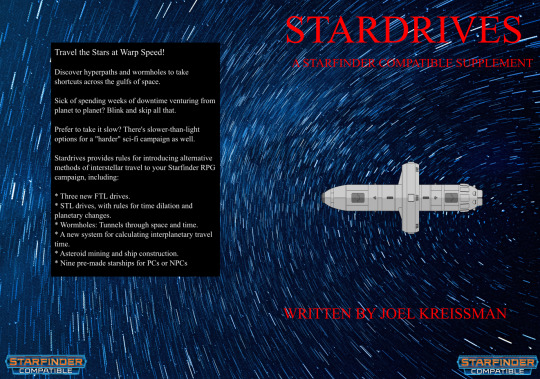
I got into contact with someone else at DriveThruRPG yesterday, and now Stardrives is available in print as well as PDF at https://www.drivethrurpg.com/product/417828/Stardrives
There were some issues, grappling with opaque PDF formatting requirements, printer sending me the wrong book entirely instead of the proof, but now you can buy my first RPG book in softcover print.
Thank you to those who backed the Kickstarter or have already purchased copies of the PDF, your support means so much to me.
3 notes
·
View notes
Text


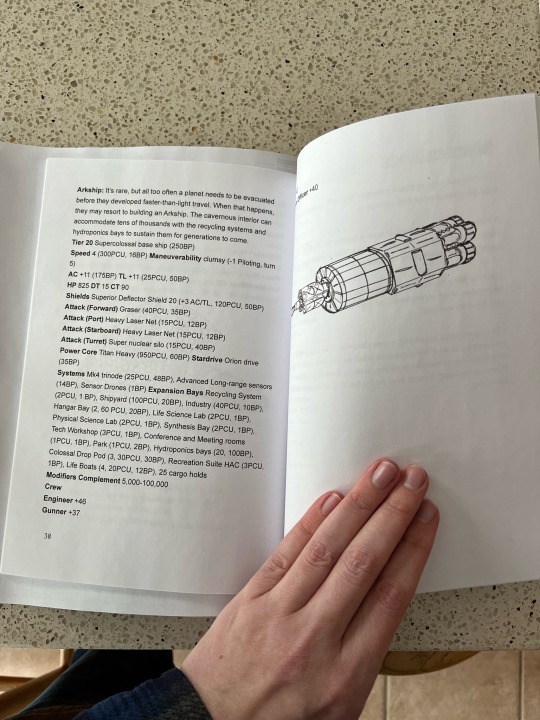

The proof has finally arrived!
Everything looks good, including the OGL 1.0 text (I’ll probably change that to ORC once it’s available), so I’ll be putting the print up for sale ASAP.
#starfinder#rpg#kickstarter#scifi#science fiction#tabletop games#starship#roleplaying game#tabletop rpg#spaceship#starfinder rpg#book cover#ttrpg
2 notes
·
View notes
Text
Starfinder’s OGL is based on D&D3, not 5, so hopefully Stardrives and other third-party products will be fine
So okay, Wizards of the Coast is going to change the OGL (or to be more accurate: they will be making a new version of the OGL, because the nature of the OGL is such that it can not be revoked by WotC).
If you still want to produce content using the OGL 5.1 nothing will change EXCEPT it's very likely that WotC will make being able to sell products on the DM's Guild contingent on agreeing to the latest version of the OGL as well as make it so that any material explicitly compatible with One D&D will have to comply with the latest version of the OGL.
They're introducing royalties for third parties: starting in 2024 after you make a certain amount of money on your OGL product you have to start paying royalties to WotC. The number seems quite high, I can't imagine many third parties make that much money off of the OGL, but WotC clearly wants to make sure they make something out of the OGL.
They're also clarifying what you can actually use the OGL for: there's been at least one high-profile video game made under the OGL (Solasta) and Wizards wants to close that loophole: they clearly don't want third parties competing with their licensed games like Baldur's Gate 3 going forward.
35 notes
·
View notes
Text
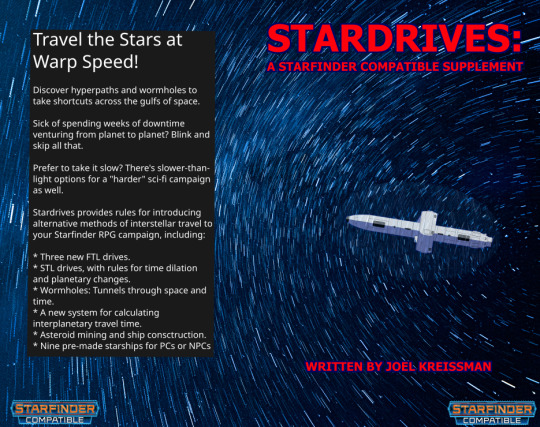
Stardrives, now on DriveThruRPG https://www.drivethrurpg.com/product/417828/Stardrives
Travel the Stars at Warp Speed!
Discover hyperpaths and wormholes to take shortcuts across the gulfs of space.
Sick of spending weeks of downtime venturing from planet to planet? Blink and skip all that.
Prefer to take it slow? There's slower-than-light options for a "harder" sci-fi campaign as well.
Stardrives provides rules for introducing alternative methods of interstellar travel to your Starfinder RPG campaign, including:
Three new FTL drives.
STL drives, with rules for time dilation and planetary changes.
Wormholes: Tunnels through space and time.
A new system for calculating interplanetary travel time.
Asteroid mining and ship consctruction.
Nine pre-made starships for PCs or NPCs
17 notes
·
View notes
Text
Stardrives is live on DriveThruRPG!
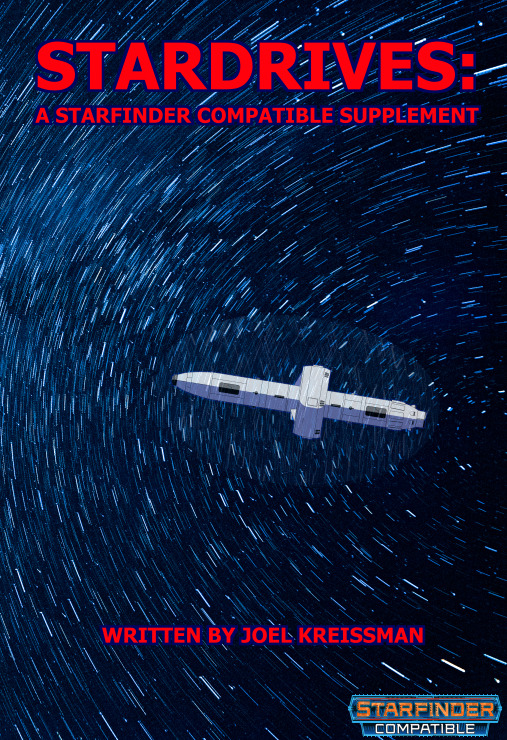
For just 99 cents you can now download a 36-page PDF of new starship and space exploration options for your Starfinder game.
44 notes
·
View notes
Text
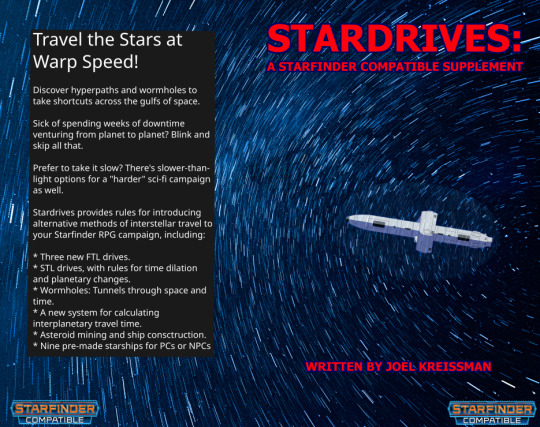
Finishing up on the final touches for Stardrives, my Starfinder-compatible OGL project with new methods of interstellar travel that act and feel dramatically different from Drift travel.
The PDF version should be up in a week or two, depending on when I get this cover finished up.
For more details see the Kickstarter campaign here: http://kck.st/3whPP09
1 note
·
View note
Text

After some more tweaking
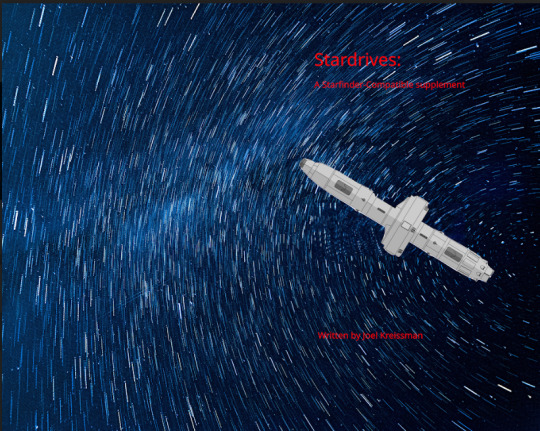
A second draft of the cover for Stardrives, an OGL supplement for Starfinder introducing three new faster-than-light drives and two methods of slower-than-light travel.
Coming soon to DriveThruRPG.
3 notes
·
View notes
Text

A second draft of the cover for Stardrives, an OGL supplement for Starfinder introducing three new faster-than-light drives and two methods of slower-than-light travel.
Coming soon to DriveThruRPG.
3 notes
·
View notes
Text
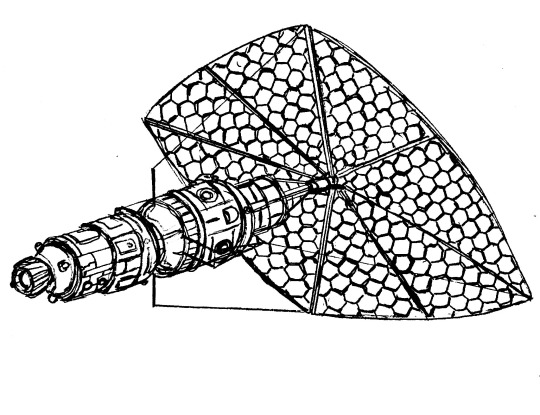
Another ship drawn by Ruddy Rose at https://www.instagram.com/anonymous_on_the_net/ for my Stardrives project. Which made funding just over a month ago! http://kck.st/3whPP09
The Sunpetal-class explorer is just 42 meters long fully extended. It mounts a single low output fusion engine and a set of 12 gimbaled verniers for maneuvering and acceleration. Solar sails can accelerate a thousand kilometers a minute in interstellar space. Typically crewed by 2-3 explorers and scientists but can accommodate up to 6 crew and 50 more passengers in cryonic stasis. Enough to survey a star system for future colonization by larger arks.
Stardrives contains statistics for a wide variety of slower-than-light drives, given how much time scientists and authors have spent exploring their feasibility, but solar sails are unique among them. For one thing they are considerably faster when pushed by a laser projected from another ship or station than relying on natural sunlight. For another that sail makes them a much bigger and less maneuverable target when deployed, in game terms they act as if two size categories larger. They can retract the sail if they suddenly find themselves in combat, but that takes time.
1 note
·
View note
Text
Created new Discord server for Starfinder, looking for players!
I made a Discord server for my Starfinder project, Stardrives. In particular for playtesting the rules before I get ready to publish it. https://discord.gg/9ry7m6u9 I got one really enthusiastic player already but need at least one more, preferably two or three.
Posted using PostyBirb
1 note
·
View note
Text
Organizing a Starfinder campaign
To playtest some of the rules from my recently Kickstarted Stardrives supplement, I'm looking for players for a military-oriented campaign set during the Drift Crisis as the Marixah Republic/Gideron Authority conflict heats up.
Players would be Marixah privateers hired to provide security for a field test of an experimental FTL drive intended to compete with Gideron's Helldrives. I'd like to start at level 5 and use the squadron rules from SOM, though you could run a single large ship if you'd prefer.
I'm on CST time and available evenings except on Monday, hoping for 3-6 players.
If you're interested please reply.
0 notes
Text
https://www.kickstarter.com/projects/joel-kreissman/stardrives-a-starfinder-compatible-shipbuilding-toolkit
One day left
kickstarter
0 notes

